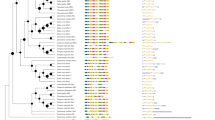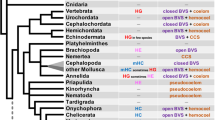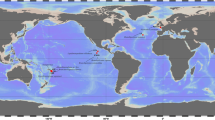Abstract
Originating from a benthic ancestor, the suborder Notothenioidei (the dominant fish fauna component of the Antarctic sea) underwent a remarkable radiation, which led notothenioids to fill several niches. The ecological importance of notothenioids in Antarctica and their biochemical adaptations have prompted great efforts to study their physiology and phylogeny, with special attention to the evolutionary adaptation of the oxygen-transport system. We herewith report the evolutionary history of α- and β-globins under the assumption of the molecular clock hypothesis as a basis for reconstructing the phylogenetic relationships among species. These studies have been extended to fish species of other latitudes, including the Arctic region. The northern and southern polar oceans have very different characteristics; indeed, in many respects the Antarctic and Arctic ichthyofaunas are more dissimilar than similar. Our results show that the inferred phylogeny of Arctic and Antarctic globins is different. Taking advantage of the wealth of information collected on structure and function of hemoglobins, we have attempted to investigate the evolutionary history of an important physiological feature in fish, the Root effect. The results suggest that the amino acid residues reported to play a key role in the Root effect may be regarded as ancestor characters, but the lack of this effect in extant species can hardly be associated with the presence of synapomorphies.
Similar content being viewed by others
References
L Bargelloni G Lecointre (1998) Four years in notothenioid systematics: A molecular perspective. G di Prisco E Pisano A Clarke (Eds) Fishes of Antarctica. A biological overview. Springer Milan 339–353
L Bargelloni L Zane N Derome G Lecointre T Patarnello (2000) ArticleTitleMolecular zoogeography of Antarctic euphausiids and notothenioids: From species phylogenies to intraspecific patterns of genetic variation. Antarctic Sci 12 259–268
T Brittain (1987) ArticleTitleThe Root effect. Comp Biochem Physiol 86B 473–481 Occurrence Handle1:CAS:528:DyaL2sXksFChsLk%3D
L Chen AL DeVries CHC Cheng (1997) ArticleTitleConvergent evolution of antifreeze glycoproteins in Antarctic notothenioid fish and Arctic cod. Proc Natl Acad Sci USA 94 3817–3822 Occurrence Handle10.1073/pnas.94.8.3817 Occurrence Handle1:CAS:528:DyaK2sXis1aqsL8%3D Occurrence Handle9108061
A Clarke IA Johnston (1996) ArticleTitleEvolution and adaptive radiation of Antarctic fishes. Tree 11 212–218 Occurrence Handle10.1016/0169-5347(96)10029-X
R D’Avino C Caruso M Tamburrini M Romano B Rutigliano P Polverino de Laureto L Camardella V Carratore G di Prisco (1994) ArticleTitleMolecular characterisation of the functionally distinct hemoglobins of the Antarctic fish Trematomus newnesi. J Biol Chem 269 9675–9681 Occurrence Handle1:CAS:528:DyaK2cXktVemsrc%3D Occurrence Handle8144556
AL DeVries (1988) ArticleTitleThe role of antifreeze glycopeptides and peptides in the freezing avoidance of Antarctic fishes. Comp Biochem Physiol 90B 611–621 Occurrence Handle1:CAS:528:DyaL1cXkvV2qtbo%3D
G di Prisco (1997) Physiological and biochemical adaptations in fish to a cold marine environment. B Battaglia J Valencia DWH Walton (Eds) Proc SCAR 6th Biol Symp “Antarctic Communities: Species, Structure and Survival. Cambridge University Press Cambridge 251–260
G di Prisco (1998) Molecular adaptations in Antarctic fish hemoglobins. G di Prisco E Pisano A Clarke (Eds) Fishes of Antarctica. A biological overview. Springer Milano 339–353
G di Prisco R D’Avino C Caruso M Tamburrini L Camardella B Rutigliano V Carratore M Romano (1991) The biochemistry of oxygen transport in red-blooded Antarctic fish. G di Prisco B Maresca B Tota (Eds) Biology of Antarctic fish. Springer Verlag Berlin Heidelberg New York 263–281
JT Eastman (1993) Antarctic fish biology: Evolution in a unique environment. Academic Press San Diego
JT Eastman (1997) ArticleTitleComparison of the Antarctic and Arctic fish faunas. Cybium 21 335–352 Occurrence Handle10.1006/taap.1993.1141 Occurrence Handle8337697
JT Eastman (2000) ArticleTitleAntarctic notothenioid fishes as subjects for research in evolutionary biology. Antarctic Sci 12 276–287
JT Eastman L Grande (1989) Evolution of the Antarctic fish fauna with emphasis on the recent notothenioids. JA Crame (Eds) Origins and evolution of the Antarctic biota. Geological Society Special Publication No. 47. Geological Society of London . 241–252
MB Fairbanks JR Hoffert PO Fromm (1969) ArticleTitleThe dependence of the oxygen concentrating mechanism of the teleost eye (Salmo gairdneri) on the enzyme carbonic anhydrase. J Gen Physiol 54 203–211 Occurrence Handle1:CAS:528:DyaF1MXlt1SqsLY%3D Occurrence Handle4978732
M Farmer HJ Fyhn UEH Fyhn RW Noble (1979) ArticleTitleOccurrence of Root effect haemoglobins in Amazonian fishes. Comp Biochem Physiol 62A 115–124 Occurrence Handle1:CAS:528:DyaE1MXitVSlu7Y%3D
J Felsenstein (1995) PHYLIP: Phylogeny inference package, version 3.572. University of Washington Seattle
O Gon PC Heemstra (Eds) (1990) Fishes of the Southern Ocean. JLB Smith Institute of Ichthyology. Grahamstown South Africa
N Ito NH Komiyama G Fermi (1995) ArticleTitleStructure of deoxyhaemoglobin of the Antarctic fish Pagothenia bernacchii with an analysis of the structural basis of the Root effect by comparison of the liganded and unliganded haemoglobin structures. J Mol Biol 250 648–658 Occurrence Handle10.1006/jmbi.1995.0405 Occurrence Handle1:CAS:528:DyaK2MXnt1agtrs%3D Occurrence Handle7623382
S Kumar K Tamura M Nei (1994) ArticleTitleMEGA: Molecular evolutionary genetic analysis software for microcomputers. Comput Appl Biosci 10 189–191 Occurrence Handle1:CAS:528:DyaK2cXltVOmsb0%3D Occurrence Handle8019868
L Mazzarella R D’Avino G di Prisco C Savino L Vitagliano CE Moody A Zagari (1999) ArticleTitleCrystal structure of Trematomus newnesi hemoglobin re-opens the Root effect question. J Mol Biol 287 897–906 Occurrence Handle10.1006/jmbi.1999.2632 Occurrence Handle1:CAS:528:DyaK1MXis1Kksbs%3D Occurrence Handle10222199
MF Perutz M Brunori (1982) ArticleTitleSterochemistry of cooperative effects in fish and amphibian hemoglobins. Nature 229 421–426
MF Perutz G Fermi B Luisi B Shaanan R Liddington (1987) ArticleTitleStereochemistry of cooperativity mechanism in hemoglobin. Acc Chem Res 20 309–321 Occurrence Handle1:CAS:528:DyaL2sXlt12iur8%3D
E Pisano C Ozouf-Costaz V Prirodina (1998) Chromosome diversification in Antarctic fish (Notothenioidei). G di Prisco E Pisano A Clarke (Eds) Fishes of Antarctica. A biological overview. Springer Milano 339–353
A Riggs (1988) ArticleTitleThe Bohr effect. Annu Rev Physiol 50 181–204 Occurrence Handle10.1146/annurev.ph.50.030188.001145 Occurrence Handle1:CAS:528:DyaL1cXhvVahtbs%3D Occurrence Handle3288090
JT Ruud (1954) ArticleTitleVertebrates without erythrocytes and blood pigment. Nature 173 848–850 Occurrence Handle13165664
N Saitou M Nei (1987) ArticleTitleThe neighbor-joining method: A new method for reconstructing phylogenetic trees. Mol Biol Evol 4 406–425 Occurrence Handle1:STN:280:BieC1cbgtVY%3D Occurrence Handle3447015
WT Stam JJ Beintema R D’Avino M Tamburrini G di Prisco (1997) ArticleTitleMolecular evolution of hemoglobin of Antarctic fishes (Notothenioidei). J Mol Evol 45 437–445 Occurrence Handle1:CAS:528:DyaK2sXms1WltLw%3D Occurrence Handle9321422
N Takezaki A Rzhetsky M Nei (1995) ArticleTitlePhylogenetic test of the molecular clock and linearized tree. Mol Biol Evol 12 823–833 Occurrence Handle1:CAS:528:DyaK2MXns1yqsbg%3D Occurrence Handle7476128
JD Thompson TJ Gibson F Plewniak F Jeanmougin DG Higgins (1997) ArticleTitleThe CLUSTAL X windows interface: Flexible strategies for multiple sequence alignment aided by quality analysis tools. Nucleic Acids Res 25 4876–4882 Occurrence Handle1:CAS:528:DyaK1cXntFyntQ%3D%3D Occurrence Handle9396791
C Verde V Carratore A Riccio M Tamburrini E Parisi G di Prisco (2002) ArticleTitleThe functionally distinct hemoglobins of the Arctic spotted wolffish Anarhichas minor. J Biol Chem 277 36312–36320 Occurrence Handle10.1074/jbc.M202474200 Occurrence Handle1:CAS:528:DC%2BD38XnsVCjt78%3D Occurrence Handle12118003
Author information
Authors and Affiliations
Corresponding author
Rights and permissions
About this article
Cite this article
Verde, C., Parisi, E. & di Prisco, G. The Evolution of Polar Fish Hemoglobin: A Phylogenetic Analysis of the Ancestral Amino Acid Residues Linked to the Root Effect . J Mol Evol 57 (Suppl 1), S258–S267 (2003). https://doi.org/10.1007/s00239-003-0035-y
Received:
Accepted:
Issue Date:
DOI: https://doi.org/10.1007/s00239-003-0035-y




